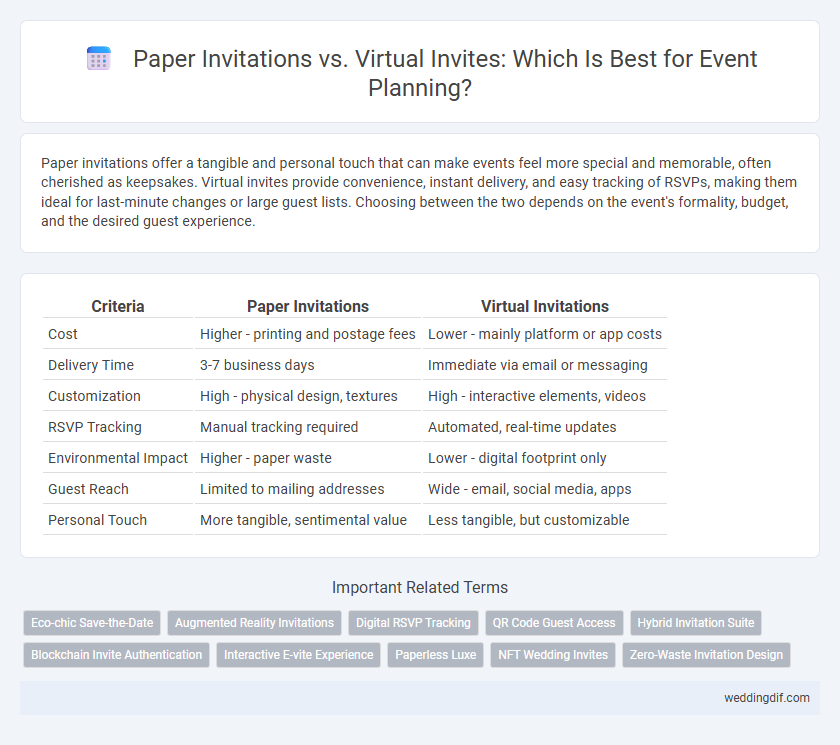Paper invitations offer a tangible and personal touch that can make events feel more special and memorable, often cherished as keepsakes. Virtual invites provide convenience, instant delivery, and easy tracking of RSVPs, making them ideal for last-minute changes or large guest lists. Choosing between the two depends on the event's formality, budget, and the desired guest experience.
Table of Comparison
| Criteria | Paper Invitations | Virtual Invitations |
|---|---|---|
| Cost | Higher - printing and postage fees | Lower - mainly platform or app costs |
| Delivery Time | 3-7 business days | Immediate via email or messaging |
| Customization | High - physical design, textures | High - interactive elements, videos |
| RSVP Tracking | Manual tracking required | Automated, real-time updates |
| Environmental Impact | Higher - paper waste | Lower - digital footprint only |
| Guest Reach | Limited to mailing addresses | Wide - email, social media, apps |
| Personal Touch | More tangible, sentimental value | Less tangible, but customizable |
Environmental Impact: Paper vs Digital Invites
Paper invitations generate significant environmental impact due to deforestation, water usage, and carbon emissions during production and transportation, contributing substantially to landfill waste. Digital invitations drastically reduce this footprint by eliminating paper consumption and physical delivery, lowering greenhouse gas emissions and resource depletion. Choosing virtual invites supports sustainable event planning by minimizing ecological damage and promoting eco-friendly communication methods.
Cost Comparison: Printing vs Sending Virtual Invites
Paper invitations typically involve higher costs due to expenses for printing, envelopes, and postage, often ranging from $1 to $5 per invite depending on design complexity. Virtual invites drastically reduce costs by eliminating physical materials and postage, relying primarily on platforms or email services that may offer free or low-cost options. For large events, virtual invitations present a more budget-friendly alternative, allowing planners to allocate funds toward other essentials.
Personal Touch: Tangibility and Sentimentality
Paper invitations provide a tangible experience that enhances the personal touch of event planning, allowing recipients to physically hold and cherish the invite as a sentimental keepsake. The texture, design, and handwritten elements of paper invitations evoke stronger emotional connections compared to virtual invites. Sentimentality in paper invitations often contributes to a more memorable and meaningful event impression for guests.
Customization and Design Flexibility
Paper invitations offer tactile customization options such as embossing, foil stamping, and textured cardstock, allowing for a unique and tangible design experience. Virtual invites provide extensive design flexibility with dynamic templates, interactive elements, and real-time updates that can be easily personalized to fit any theme or occasion. Choosing between paper and virtual invitations depends on the desired level of customization and the value placed on physical keepsakes versus digital convenience.
Delivery Speed: Instant vs Traditional Mail
Virtual invitations offer unparalleled delivery speed, arriving instantly via email or messaging apps, which significantly accelerates event planning timelines. Traditional paper invitations rely on postal services, often requiring days to weeks for delivery, potentially causing delays in receiving RSVPs. This contrast in delivery speed impacts the efficiency and responsiveness of event coordination, making virtual invites the preferred choice for time-sensitive planning.
Easiness of RSVP Management
Virtual invites streamline RSVP management by providing automatic tracking and real-time updates, reducing the risk of lost or delayed responses common with paper invitations. Digital platforms often integrate with calendars and event management tools, enabling organizers to efficiently monitor guest confirmations and dietary preferences. Managing RSVPs electronically saves time and decreases errors, enhancing overall planning accuracy and responsiveness.
Accessibility for All Guests
Paper invitations provide tactile engagement, ensuring accessibility for guests with limited digital literacy or unreliable internet access. Virtual invites offer customizable features such as screen reader compatibility and adjustable text sizes, catering to diverse accessibility needs. Combining both methods maximizes inclusivity, reaching guests across different technological and physical abilities.
Additional Features: Multimedia and Interactivity
Virtual invites offer enhanced planning capabilities with multimedia integration such as video messages, animations, and music that engage recipients more effectively than traditional paper invitations. Interactive elements like RSVP tracking, polls, and customizable event details streamline organization and improve guest participation. These additional features optimize communication and reduce logistical challenges in event planning.
Etiquette and Traditional Expectations
Paper invitations remain the gold standard in etiquette for formal events, symbolizing respect and thoughtfulness through tangible, personalized touches. Traditional expectations emphasize the importance of handcrafted details and physical delivery, which often convey sincerity and a higher level of commitment in event planning. Virtual invites, while efficient and cost-effective, may be perceived as less formal, making them more suitable for casual gatherings or eco-conscious celebrations.
Security and Privacy Considerations
Paper invitations offer stronger privacy controls as they are less susceptible to digital hacking and data breaches, ensuring personal information stays secure. Virtual invites, while convenient, require robust encryption and secure platforms to protect guest data from unauthorized access. Choosing the right invitation method depends on the sensitivity of event details and the level of privacy desired by the organizer.
Paper invitations vs virtual invites for planning. Infographic

 weddingdif.com
weddingdif.com